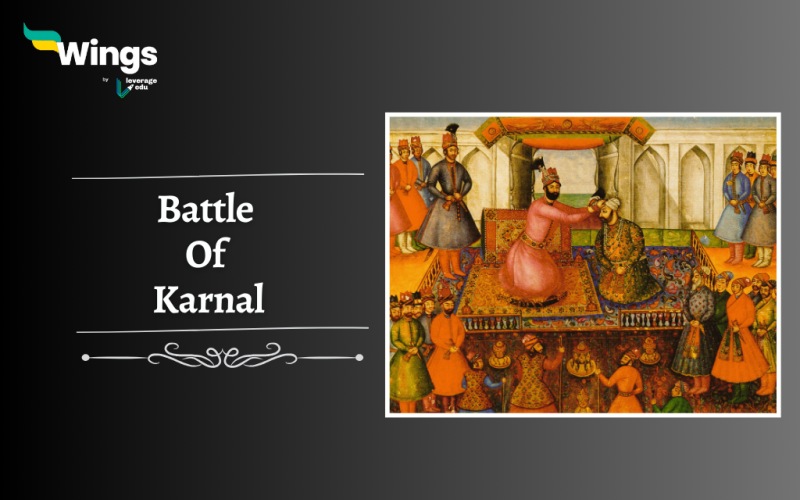The Battle of Karnal was fought on 24th February 1739 in the Karnal of Haryana. It took place between Nadir Shah, who was the founder of the Afsharid dynasty and the Mughal Empire. The battle resulted in the invasion of Nadir Shah in India and the defeat of the Mughals within just three hours of the war. It was crowned one of the best masterpieces of the military career and tactics of Nadir Shah. Let us get to know more information about the battle in the blog.
| Battle of Karnal Overview | |
| Battle Took Place On | 24th February, 1739 |
| Place | Karnal, Haryana |
| Fought Between | Nadir Shah Vs Mughal Empire |
| Won By | Nadir Shah |

Background Of The Battle
Nadir Shah became the Shahanshah of the Persian Empire. He was a brilliant military strategist who was able to expand his empire through his tactical expertise and military reforms. At the peak of his power, his empire spanned from the Black Sea to the Persian Gulf and included modern-day countries such as Pakistan, Oman, Georgia, Armenia, etc
- Throughout his reign, Shah was constantly battling with warlords in Afghanistan. Some of these defeated warlords had fled to the border areas with the Mughal Empire seeking asylum.
- Shah made requests to the governors of the northern Indian regions who were under the Mughals to hand over the absconding Afghani warlords to him, but this request was largely ignored. Shah used this as a justification to declare war against the Mughal Empire.
- During Shah’s time, the Mughal Empire was under the rule of Muhammad Shah, and his rule saw a crucial decline in the once-powerful empire.
- Taking advantage of the situation, Nadir Shah took the opportunity and asked his troops to wage a war by entering Kandahar.
- The frontier governors initially resisted the Persian attack but were later defeated by the invading army.
- On November 16, 1739, Shah and his troops left Peshawar and headed towards the Sindh River in Punjab.
- The governor of Lahore tried to resist the Persian army but surrendered to avoid being overpowered.
- He paid Shah Rs.2 million in exchange for securing his position as the ruler of Lahore.
- Upon learning of the Persian army’s advance, Muhammad Shah led a large army of about 3,00,000 soldiers, accompanied by 2000 elephants and 3000 guns, out of Delhi to face the invaders and prevent them from entering his capital.
Also Read – Battle of Plassey: History, Context, and Legacy
Event Of The Battle
Nader Shah led a smaller army than his opponent, but it was better equipped and better trained.
- Nader Shah ensured that his army had updated weapons and lighter arms, making them easier to operate than the Mughal army’s outdated ammunition.
- Moreover, the Persian army included zamburaks (cannons which were mounted on camels) and provided easy mobility for carrying heavy guns.
- The Persian army consisted of uniformly drilled soldiers from the Persian state and areas subjugated by Nader Shah, whereas the Mughal army was composed of different factions and lacked cohesiveness.
- The Mughal army arrived at Karnal, which is about 120 km north of Delhi in the modern Indian state of Haryana. They met Nader Shah’s smaller force on 24 February for battle.
- Using surveillance, intelligence techniques and shrewd military tactics, Nadir Shah’s small force, however, outnumbered the Mughal army in a day-long battle.
- The Persian forces were able to wreak havoc amongst the miserable Mughal soldiers and many of their high-ranking chiefs were either murdered or taken as war prisoners.
Also Read – Battle Of Diu: Background, Event, Outcome & More
Outcome Of The Battle
At first, the Persian warriors did not pillage Delhi, however, Nadir Shah ordered the city to be sacked after a violent altercation broke out. His forces massacred the people of the city in a ruthless manner.
- Their money was taken and people were slaughtered in their houses. It is estimated that almost 30,000 individuals have been killed.
- Many chose to give up their lives and the lives of their loved ones rather than give themselves over to the Persian warriors since the atrocities were so severe. Some said there were hundreds of dead bodies all across the city.
- Nearly, 400 Mughal officers and about 20 to 30 thousand soldiers were killed in the battle. Muhammad Shah finally had to accept his defeat and had to take Nadir Shah to his capital. The Persians eventually looted the entire treasury of the Mughals.
- After several days of the sacking of Delhi, Nader Shah gave the command for his forces to stop.
- Nader Shah and his army departed the city in May 1739. And, Muhammad Shah continued to rule as the Mughal Empire’s emperor.
- However, his coffers were nearly empty. The renowned Peacock Throne, the Koh-I-Noor, and the Darya-ye-Noor diamonds were among Nader Shah’s loot.
- Nadir Shah was also given all of the Mughal land located to the west of the Indus River.
The Mughal Empire, which was already in decline, was further weakened by Nadir Shah’s catastrophic invasion. This invasion exposed the vulnerabilities and flaws of the Mughal Empire and alerted the British East India Company of the possibility of expanding their reach.
Relevant Blogs
This was all about the Battle of Karnal. For more content related to the different states of India, visit our articles like this, you can get Study notes on the Modern History of India here. Also, you can visit our general knowledge page on Indian History!
 One app for all your study abroad needs
One app for all your study abroad needs













